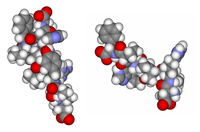
Photo from wikipedia
Objectives: AGT synthesis is believed to occur in liver, kidney, brain and adipocytes, so that selectively deleting hepatic AGT may not alter renal angiotensin (Ang) levels. Here we investigated whether… Click to show full abstract
Objectives: AGT synthesis is believed to occur in liver, kidney, brain and adipocytes, so that selectively deleting hepatic AGT may not alter renal angiotensin (Ang) levels. Here we investigated whether arterial pressure lowering with liver-targeted AGT siRNA versus renin-Ang system (RAS) blockers affects renal function and Ang levels. Methods: Arterial pressure was measured via radiotelemetry in spontaneously hypertensive rats during vehicle, valsartan, captopril (both p.o.), siRNA (fortnightly s.c. injection), siRNA + valsartan or captopril + valsartan treatment for 4 weeks. Transcutaneous measurement of glomerular filtration rate (GFR) and 24 h urinary excretory function was assessed at 2 and 4 weeks. Renal Ang levels were measured by mass spectrometry. Results: Dual RAS blockade synergistically lowered arterial pressure compared to monotherapy. Valsartan increased AngI (P < 0.05), while captopril ± valsartan did not affect AngI. siRNA ± valsartan lowered AngI by > 30% (both P < 0.01). In contrast, neither siRNA nor valsartan lowered AngII. Captopril modestly lowered AngII while dual RAS blockade greatly reduced AngII (all P < 0.05). The renal AngII/I ratio was increased 4-fold after siRNA, reduced by > 70% after valsartan and captopril ± valsartan (all P < 0.05) and unaltered after siRNA + valsartan. No treatment affected GFR, natriuresis or albuminuria. Conclusion: The lowering of renal AngI after liver-targeted AGT siRNA suggests that hepatic rather than renal AGT determines renal Ang generation. Upregulation of ACE and/or AT1 receptors may allow renal AngII to remain intact after siRNA, and only dual RAS blockade annihilates renal AngII. AGT siRNA synergistically lowers arterial pressure when combined with existing RAS blockers and may be a novel treatment for hypertension without apparent negative effects on renal function.
Journal Title: Journal of Hypertension
Year Published: 2018
Link to full text (if available)
Share on Social Media: Sign Up to like & get
recommendations!